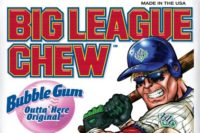The ubiquitous gumball machine. So common, so cherished, so twentieth century? Although most Baby Boomers can recall bothering parents for pennies and nickels so they could turn the knob on the classic stand-alone fixture found throughout businesses and shops, that experience isn’t as common today as it once was.
George Stege, president of Akron, N.Y.-based Ford Gum & Machine Co., the lone U.S. manufacturer of gumballs, can attest to the changes that have affected the gumball machine segment, and to a larger extent, the chewing gum category. Having joined the company in 1980 as its marketing director, the chief executive and majority owner of Ford Gum, has personally experienced the shifts in the retail landscape. Those shifts, coupled with a graying of America, have diminished the presence of gumball machines.
The emergence and popularity of shopping and strip malls, coupled with the disappearance of small-town independent businesses, have slashed the placement of gumball machines by distributors, he explains
“For a variety of reasons, chain operators in the malls don’t want gumball machines in the shops,” he says. “In 1980, bulk vending [supplying gumballs to distributors filling gumball machines] represented 80% of our business. Today, it ranks third behind our retail and private label business. The business has changed dramatically.”
But Ford Gum — as its 100th anniversary celebration this year dramatically emphasizes — has adapted to those changes accordingly. As Stege points out, not every company can point to providing consumers with a century of chew. It’s an accomplishment few companies, confectionery or otherwise, can tout.
Beginning with founder Ford Mason’s desire to earn some extra money, which propelled him into first supplying, then building gumball machines, the company has evolved into an entrepreneurial confectionery manufacturer that’s particularly poised to embrace the challenges of the coming second century.
While Ford Gum remains committed to its heritage — the company supplies more than 300 gumball distributors with bulk gumballs — it’s continuously looking to take further advantage of its core competency, making gumballs and tablets.
“When the six of us [John Kennelly, current cfo; Steve Greene, current senior v.p. of marketing; Steve Gold, Warren Clark and Stege] purchased Ford Gum from Hershey Holdings in 1997 in a leveraged buyout, we saw opportunities in the marketplace for the company,” Stege explains.
As he says, after doing a review of the company’s strengths as part of a strategic planning process, it was clear Ford Gum could successfully participate within the private label as well as branded sectors.
“Because of our size, we could attract private label customers,” Stege says. “If you wanted sugarless, private label product, you’re coming here.”
It was the retail confectionery market that posed the bigger challenge for Ford Gum. At the time, excluding Carousel, the company didn’t have a formidable brand of its own.
Looking to take advantage of a niche in the marketplace, the company created a new product and brand.
“We put 12 gumballs in a tube and called it Yowser,” Stege says. It was shortly thereafter that the new chief executive learned a lesson about the power of existing brands as well as retailers’ affinity for such brands.
After acquiring the license from Smarties to create gumballs, the company decided to offer retail customers a similar branded tube proposal. Stege, however, wasn’t convinced confectionery buyers would accept the pitch.
“I thought we had a non-starter,” he says. “First, they would be getting 10 gumballs in a tube, not 12. Second, it was going to cost them 30% more, because we had to pay a royalty fee.”
Despite such hurdles, the Smarties launch proved successful.
“We sold more Smarties gumballs in the first quarter than the Yowser brand did in one year.”
Shortly thereafter, Stege seized the opportunity to produce Mike & Ike and Hot Tamale gumballs under license from Just Born. But it was in 2010 that the company made a truly major brand acquisition; it picked up Big League Chew from Wm. Wrigley Co.
Originally developed by minor league pitcher Rob Nelsen, who enlisted Jim Bouton, former New York Yankees pitcher and author of Ball Four, to help sell the gum as an alternative to chewing tobacco, Big League Chew, represented Ford Gum’s first major brand acquisition.
After Mars acquired the Wm. Wrigley Co. in 2008, new management determined that certain brands were dispensable. Not one to hesitate, Stege made the acquisition, which included the manufacturing line that was sitting in Mexico at the time.
Part of being an entrepreneur is “taking advantage of the opportunities that come along when you least expect it,” he adds.
Although reassembling the line proved challenging — “Our maintenance crew did wonders putting it back together without any drawings whatsoever,” says Mark Wagner, director of operations — the results soon confirmed Stege’s thinking about brands.
“We were able to equal Wrigley’s sales in the first year,” he says. “This year, we’ll grow by 20-30%. As a smaller company, we can focus on a branded product.”
Big League Chewnow accounts for nearly 30% of the company’s total sales. Such numbers have prompted Stege and his management team to seek out other brands. Currently, the company is in negotiations for two possible acquisitions, which it hopes to finalize this year.
The company also looks to take advantage of seasonal opportunities, particularly Easter. As Steve Greene, sr. v.p. of sales and marketing, points out, gumballs in Easter packaging do well. Moreover, last year, the company introduced Big League Chew Jumbo Plastic Eggs, which feature three packs of Big League Chew, trading cards and tattoos.
The “soft launch” did incredibly well in limited markets and the company looks to expand distribution this year. Naturally, the fact that the baseball season dovetails with Easter provides added impetus for impulse sales.
But, as mentioned earlier, branding represented only one of the opportunities Stege and the buyout team recognized back in 1987. Private-label sales loom large for Ford Gum Co., accounting for the second largest chunk of revenues.
Citing such players as CVS, Walgreens, A&P, Wise, Giant Eagle and others, Stege says Ford Gum was able to provide its expertise to retailers seeking to offer better values within the gum segment. To help him make his case, he enlisted the services of Roger McEldowney, the retired president and ceo of Mayfair Sales, one of the largest private-label rebaggers in the nation.
“Private-label brands provide companies like Ford Gum another way to gain distribution within retail,” he says. “Within the gum category, you have 57 different items in a typical 7/Eleven convenience store. The category is controlled by two producers.”
Hence, for companies such as Ford Gum, private-label provides a way to access this major confectionery segment, McEldowney adds, particularly when it [private-label confections] is in a growth mode.
“Private-label confections are growing significantly, with non-chocolate doing so substantially,” he says. “Chocolate is growing, but to a lesser extent. And private-label gum is also growing, but its gains come from a smaller base. We’re looking to do 50% more private-label business this year.”
Such a growth forecast suggests potential growing pains for the company, which occupies a 98,000-sq.-ft. manufacturing and office complex in Akron. But as Kennelly, Ford Gum’s cfo, points out, aside from dealing with competitive pressures brought on by government regulations — specifically the U.S. subsidized sugar program — the company has the benefits of being in an almost ideal location.
First, it can draw gas from an existing underground gas reservoir. There is — on its property — a gas well that supplies fuel to address any heating demands for the plant and offices. Second, there are abandoned underground gypsum mines also underneath the company’s property. They contain chilled water that’s accumulated there over the years. The company pumps that water from the mines and uses it as a cooling source for its production needs. Finally, Akron and several surrounding small cities have a sweetheart deal with the regional utility company. As a result, Ford Gum benefits from a discounted electrical rate.
Kennelly estimates that without these benefits, energy costs would total four times higher than what the company has today.
Those savings are being channeled toward future improvements within the plant — such as further automating the Big League Chew production line to minimize manual handling during sheeting, breaking and packing — as well as preparing for the company’s centennial bash.
On July 27, the company will hold a celebration for current and past employees, bulk vending distributors, past and retired customers as well as local dignitaries, city, state and federal politicians on its grounds.
In reflecting on the milestone, Stege says it is the highlight of his career. “I’ve been with the company for more than 30 years and its history is my history; it’s our employees’ history, our brokers’ and customers’ history. And for all of the children — now grandparents — who put their pennies in those gumball machines long ago, it’s their history as well.”
More importantly, thanks to Stege and his management team, Ford Gum continues to make history.
Ford Gum & Machine Co.
Headquarters:Akron, N.Y.
Sales: $30-$50 million (Candy Industry estimate)
Employees: 90
Plant: 98,000 sq. ft. (gumball and tablet lines)
Brands: Carousel, Big League Chew, Smarties
Management team: George Stege, president; John Kennelly, cfo; Steve Greene, senior v.p. – sales and marketing; Mark Wagner, director of operations.
Ford Gum and Machine Co. ‘s
100-year Timeline
1913 A young, 20-year-old Ford Mason, a traveling roofing salesman, meets a man who introduces him to the gum vending business; Mason decides to take a loan and leases 102 vending machines that he services during winter months. Gumballs cost one cent.
1917 Ford Mason manufactures and introduces his own quality gumball vending machine, designed by his father. The company is known as Ford Vending Machine Co.
1927 Norris Rowbotham from Walworth, Wis., becomes the company’s first distributor.
1934 Ford Vending Machine Co. changes its name to Ford Gum & Machine Co.
1950s The company moves its headquarters and gum plant to a former dairy in Akron, N.Y., which is renovated. Manufacture of its gum machines remains in Lockport, N.Y.
1960 Remaining operations moved to Akron. The same year, the company begins contract manufacturing of tablet chewing gum for private label brands.
1970 Company purchased by Automatic Service Co.
1980 Toys and capsules added to bulk vending line.
1985 Ford Gum purchased by Leaf Inc.
1989 On August 18, at age 95, Ford Mason passes away in Delray Beach, Fla.
1996 Ford Gum and Carousel are purchased by Hershey Holdings.
1997 John Kennelly, Steve Greene, Steve Gold, Warren Clark and George Stege, purchase Ford Gum and Carousel in a management buyout. With Ford Gum and Carousel now married together, the company breaks into the retail marketplace.
1998 Ford Gum and Machine Co. unveils new corporate logo and redesign of its Carousel brand packaging.
1997 Sales and marketing office opens in Vernon Hills, Ill., a Chicago suburb.
2001 Sales and marketing office moved to Lincolnshire, Ill.
2003 Ford Gum becomes the only company manufacturing gumballs in the United States.
2010 Ford Gum acquires Big League Chew from Wm. Wrigley Co. and moves production from Mexico back to the United States.
2010 Becomes nationwide distributor of TOMY toy products.
2013 Company celebrates its 100th anniversary.





























